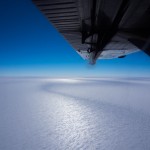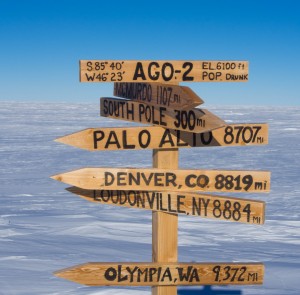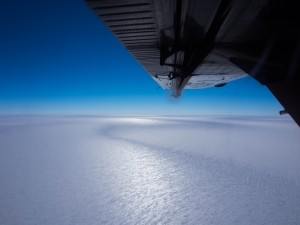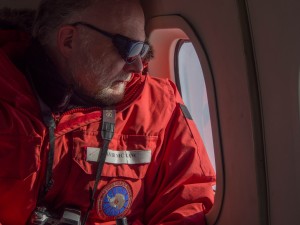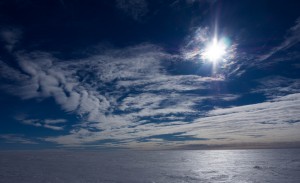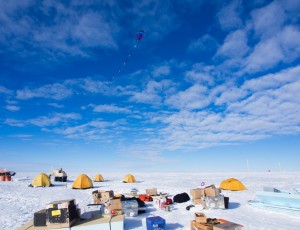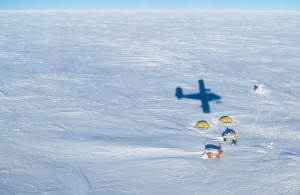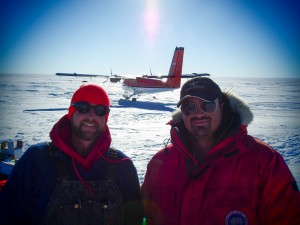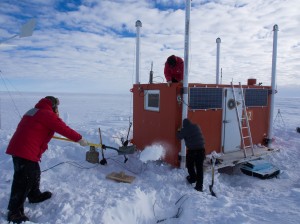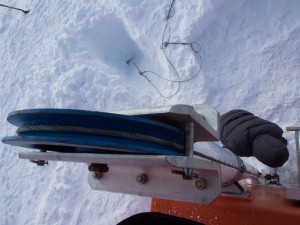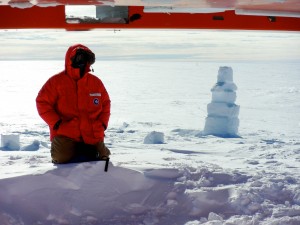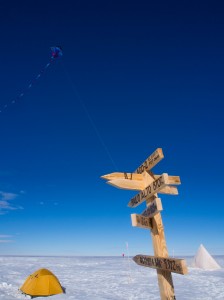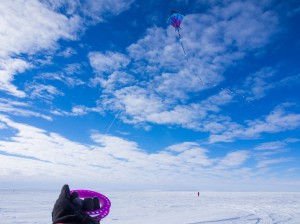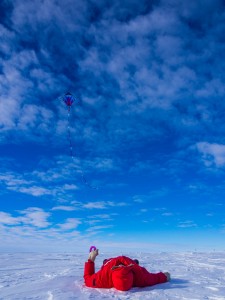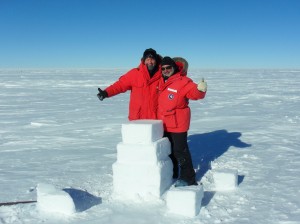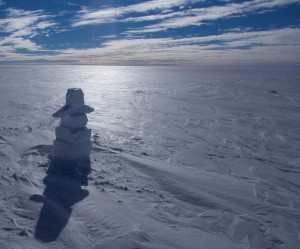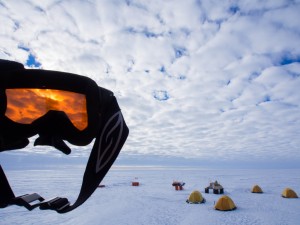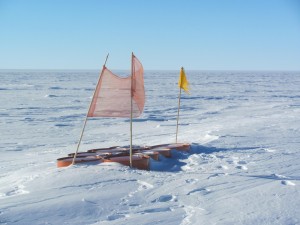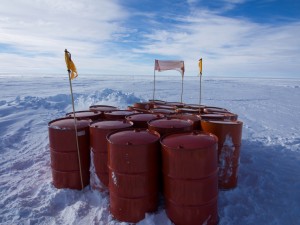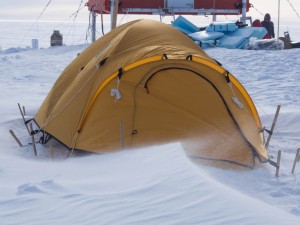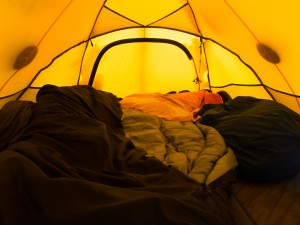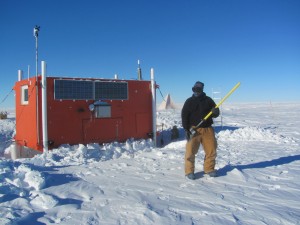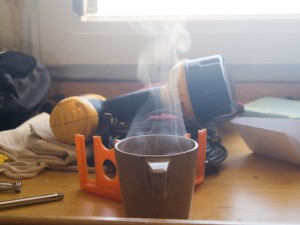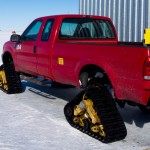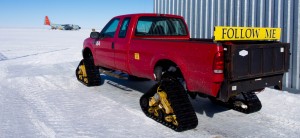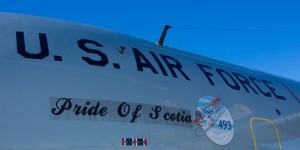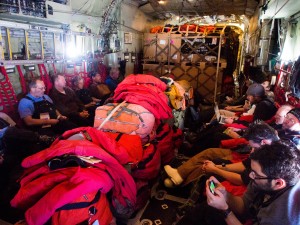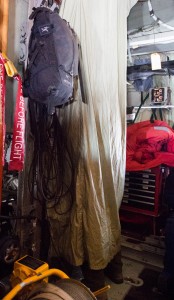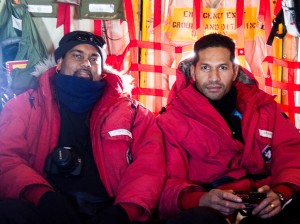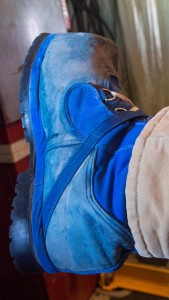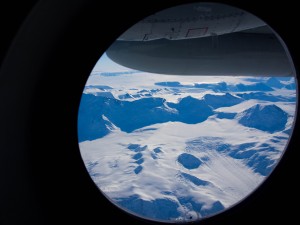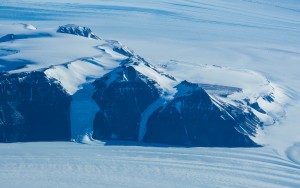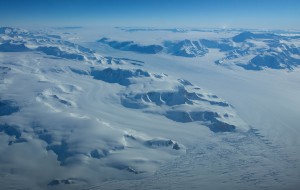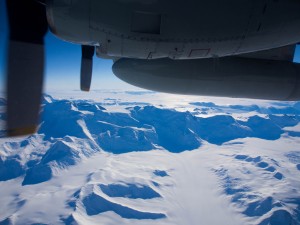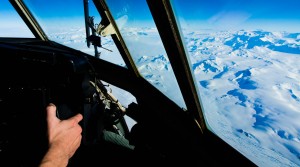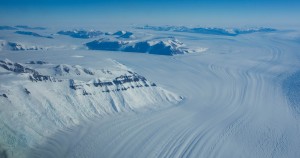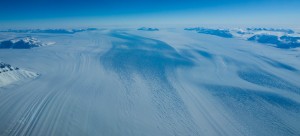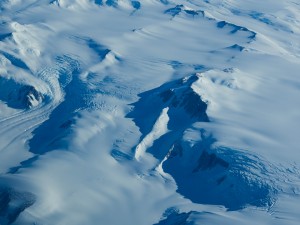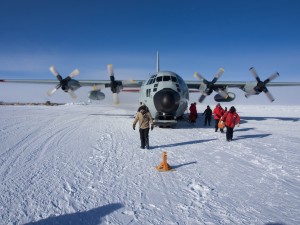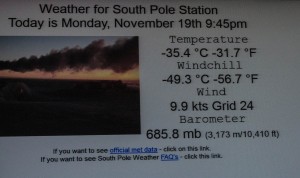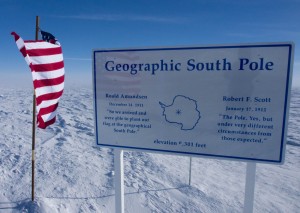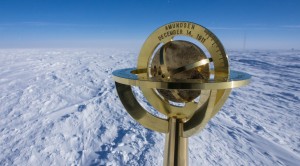As we sat in the Twin Otter awaiting our depature to AGO 2 the time seemed to creep along.
There seemed to be a hesitation that we normal don’t have.
As we heard a loud banging resinate through the plane, we became even more inquisitive.
Then the pilot popped his head in and told us that the they had to smack the skis with a 6×6 to break it loose.
The skis had frozen to the ice.
You know it will be a long day when you skis are frozen to the ice.
At least that is what my grandma always used to say.
Everything seemed to go perfectly after that first little issue.
The skies were perfect blue, displaying the varied texture of the sastrugi as it curves away beyond the horizon.
In the seats around me were David McGaw, Tim Spuck and Bob Melville, all of us settling in for the couple hour plane flight.
Time constraints had gotten the best of David and he had to leave for the states in a few days.
He flew out with us on the first put in plane, did his science work and then headed back to the South Pole on the second put in flight.
You could tell he was staring nostalgically at the plateau.
It is one of those places that you are amazed that you even ended up here once.
You certainly don’t take it for granted.
It is something none of us may ever see again after the project ends.
Its funny, while its not a classicly beautiful landscape, its beauty is in its expansive openness.
There is literally nothing like this on earth and maybe anywhere else.
It is extremely real. Its Antarctica at its most empty and massive!
With David departing we met up with a teacher named Timm Spuck who is affiliated with an organization called Polar Trec.
It puts science groups in the Polar regions together with teachers to help bring the two worlds together.
Timm proved to be a really nice guy and a great addition to the crew.
I had been lulled to sleep since the plane flys perfectly smooth.
For hours we are only a couple hundred feet above the expansive plateau.
I woke to the plane banking to the left and I stared out the window to see our new home.
The tiny orange AGO was the only thing breaking up the white snow as far as I could see.
When we landed and the pilots opened the door, I noticed one thing.
AGO 2 was so much more pleasant than AGO 3!
I suppose it’s good to start with the hardest situation first, then everything else is smooth sailing.
AGO 2 lies at 5900’ compared to AGO3 at 9600’ which made the temperature well lower.
The winds were only 5 miles an hour instead of upward of 25 mph at AGO3.
Bob explained that our AGO 3 put in was the 2nd harshest weather he had dealt with in his time in Antarctica.
Someone through the years had made a mile marker sign which provided directions in the “front yard”.
There were distances to McMurdo, South Pole but I was intrigued at the distances to places in the states.
The sign said that it was 9,372 miles to Olympia, Washington.
That’s really far!
We started setting camp after hauling all the gear from the plane to the AGO.
Tim helped me put up the Scott tent and it was pleasent enough outside that we started putting up everyone’s sleeping tents.
So much different than last time!
I know everything is relative but it was so pleasent to be outside.
I’m sure it was mostly weather but I also knew what I was walking into this time.
AGO 3 we had to huddle indoors just to not get frostbite and could only work in short bursts.
We were still outside setting up camp when the Twin Otter got back from picking up Andy and Gil.
I bet it was cool to fly over and see the AGO already springing to life.
Tents set up and people milling about.
This was to be our last flight with Phil and David as our pilots.
They were spectacular! Thanks for all the help and good times!
They were finishing up their time on the Ice and planned to get home before Christmas.
Lucky Dogs!
This trip was going to be much more in depth.
Each of the AGO’s get raised every five years in a cycle.
Luckily this year was AGO 2 which is by far the lowest elevation location and therefore the most hospitable.
The process is pretty extensive.
There is a lot of effort digging the guy lines out of the snow.
This is to loosen them so they can be extended when the AGO gets raised.
There are new platforms placed under each corner as new supports.
Then using pulleys and manual winches we raised the box inch by inch.
We made 600 revolutions to raise 5 1/2 feet.
When we were done the AGO was like a big orange tree house.
We had to climb a steep ladder to access the front door.
Just yesterday you had to climb down a set of snow steps to access our humble abode.
This is such a odd and remote place that every thing you do seems to be the strangest place to do that task.
This was certainly no different.
It has to be most remote cabin raising project on earth.
To fill our time we each found our outlets.
Taking in the surreal scenery was a base level activity.
I took it to the next level and flew a kite which I had purchased back home.
You know how many times we have all gotten our kites stuck in a the neighbors trees, well that’s not an option down here.
Heck, I haven’t seen a tree in over two months.
The kite flew high and proud with nothing but the wind turbine to worry about.
When we were finished with the AGO raising project I took a bit of time to fly the kite myself.
As I wondered around, kite in hand I saw Gil far in the distance giving scale to this juxtaposed activity.
He eventually caught up to me and enjoyed laying on the ground like he was an Antarctic 6 years old.
He flew the kite with a huge smile on his face for a half hour straight.
While working on an antennae installation we sighted a Snow Petrel flying through the sky.
It’s the only animal that any of us have seen in what feels like forever.
We ponder if the bird is the toughest thing around or just plain lost.
It’s at least 500 miles away from the coast and surrounded by a sterile nothingness of ice.
No liquid water or food for an incalculable distance.
Our pick up flight got delayed by four extra days because the weather was not good enough to fly.
Five men digressing into stinky, stir crazy oddballs with absolutly no normal sleep schedule.
We would be up till 4am watching movies and working on the electronics. Mornings came late, where we would shuffle out of our tents at noon.
Tim and I even found time to make a snow man.
Its different than making them in the states because the snow won’t stick together because its too dry and cold. What we had though was the fact that you can saw blocks perfectly and use them to stack like a cairn.
In Northern Canada the natives make cairns that are formed like little rock people.
We made the same thing out of blocks of snow and named him AGO MAN.
We decided that he was there as a sentinel looking into the blowing snow for those who can’t do so for themselves.
He was standing proud still on the days we left.
Days came and went, trying to spend our time as productively as possible.
As for myself I found that if you put your goggles up to the sun when you take a picture you can really show the difference from what our eyes see and what our goggles see.
This unleashed a rash of photos in which I forced people to stand in front of the sun so you can accent the photos with your goggles.
Hobbies, you have to have hobbies in the place like this.
Gil found himself enamoured at how rock hard the ice was that he had me take this photo of the shovel with nothing more than a 1/4 “ sticking in the ground.
Pretty bizarre.
In the respect of genuine productivity we shoveled out 37 different 55 gallon barrels of AN8 or airplane fuel.
This at least gives the fuel a few extra years before the blowing snow completely envelopes it.
The winds blew so hard that they started making wind blown burms downwind of everything including our tents.
At this same point, I would choose to just climb inside that tent and wait it out.
Any of you who received a phone call, this these are the moments.
Eight days at an AGO gets pretty long.
Sometimes you even play air bass with the shovel.
Thankfully its 2012 which allowed us to laugh at movies on our laptops.
We watched “Walk Hard: The Dewey Cox Story” and “The Other Guys”.
Warm drinks, funny movies and pretty good eating got us through.
Along with signatures from everyone that has spent long hours in this box, there was also a 20 year old bagel that was signed in 1992.
We felt compelled to add a new bagel.
Twenty years of AGO Bagels is a pretty powerful thing to witness.
Let me tell you that people!
Well, finally the weather broke.
The skies cleared, the sun came out and created a sun dog which is a huge halo.
It signaled our escape from AGO 2!
The word had come that we would be picked up in the morning!
We had to get prepared for an early pick up so we hauled all of our cargo out to the landing strip.
Everyone helped but Gil was pretty excited to get outside and stretch his legs.
The mission had been very successful!
We had raised the AGO to a height that will keep it clean of snow for years to come.
The power system was working great and seemed like it would last for years.
The data was transferring back to the U.S like it was supposed to.
All was well, and now it was time to get out of there.
We all just wanted to get back to the South Pole!
There was warm showers, soft beds and food that someone else made.
There was also a bottle of red wine to toast…TO LIFE!
